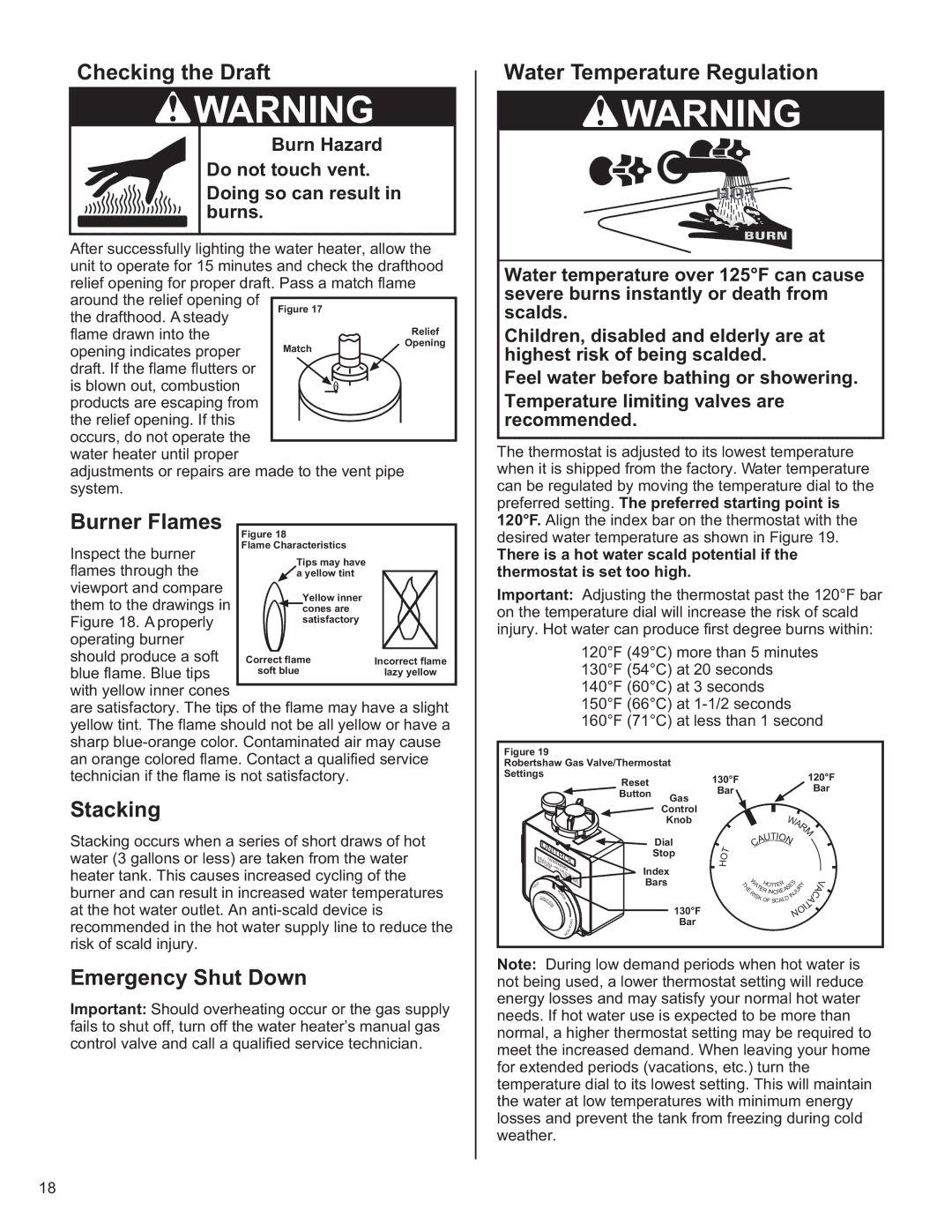
Checking the Draft
Burn Hazard
Do not touch vent.
Doing so can result in burns.
After successfully lighting the water heater, allow the unit to operate for 15 minutes and check the drafthood relief opening for proper draft. Pass a match flame around the relief opening of
the drafthood. A steady
flame drawn into the opening indicates proper draft. If the flame flutters or is blown out, combustion products are escaping from
the relief opening. If this occurs, do not operate the water heater until proper
adjustments or repairs are made to the vent pipe system.
Water Temperature Regulation
Water temperature over 125°F can cause severe burns instantly or death from scalds.
Children, disabled and elderly are at highest risk of being scalded.
Feel water before bathing or showering.
Temperature limiting valves are recommended.
The thermostat is adjusted to its lowest temperature when it is shipped from the factory. Water temperature can be regulated by moving the temperature dial to the preferred setting. The preferred starting point is 120°F. Align the index bar on the thermostat with the desired water temperature as shown in Figure 19.
There is a hot water scald potential if the thermostat is set too high.
Important: Adjusting the thermostat past the 120°F bar on the temperature dial will increase the risk of scald injury. Hot water can produce first degree burns within:
120°F (49°C) more than 5 minutes 130°F (54°C) at 20 seconds 140°F (60°C) at 3 seconds 150°F (66°C) at
Figure 19
Robertshaw Gas Valve/Thermostat
Settings
130°F | 120°F |
| UNITROL | |||
| READ W |
|
| |
| BEFORE | ARNING |
| |
| ALL | INSTRUCTIONS | ||
|
|
| ||
| T |
| LIGHTING | |
H | O |
|
|
|
|
| WA |
| |
|
|
|
| |
| C |
| R |
|
|
| M |
| |
| AU |
|
|
|
| TI |
|
|
|
| O |
|
|
|
| N |
|
| |
|
|
|
| V |
|
|
|
| A |
|
|
|
| C |
|
|
|
| A |
|
|
| NO | I T |
Reset
Button
Gas
Control
Knob
Dial
Stop
Index
Bars
130°F
Bar
Bar | Bar |
|
|
|
|
|
| W |
|
|
|
|
|
|
| |
|
|
|
|
|
|
| A |
|
|
|
|
| ||
|
|
|
|
|
|
|
| R |
|
|
|
| ||
|
|
|
| UTIO |
|
|
| M |
|
|
| |||
|
| A |
| N |
|
|
|
|
|
|
|
| ||
T | C |
|
|
|
|
|
|
|
|
|
|
| ||
|
|
|
|
|
|
|
|
|
|
|
|
|
| |
O |
|
|
|
|
|
|
|
|
|
|
|
|
|
|
H |
|
|
|
|
|
|
|
|
|
|
|
|
|
|
W |
|
| H | R |
| S |
|
| Y |
|
|
| V | |
H | A |
| E |
|
|
|
|
| ||||||
|
|
|
| O TTE |
|
|
|
|
| A | ||||
T |
|
| E |
| A |
|
| R |
|
|
|
| ||
E |
|
|
|
|
|
|
|
|
| |||||
RI | T | R INCRE | S |
| U |
|
|
| C |
|
| |||
|
|
|
|
| J |
|
|
|
|
| ||||
| S | K |
|
| IN |
|
|
| TA |
|
| |||
|
|
|
| LD |
|
|
|
|
|
|
| |||
|
|
|
| OF SCA |
|
|
|
|
|
|
|
| ||
|
|
|
|
|
|
|
|
|
| I |
|
|
| |
|
|
|
|
|
|
|
| O |
|
|
|
| ||
|
|
|
|
|
| N |
|
|
|
|
|
| ||
Note: During low demand periods when hot water is not being used, a lower thermostat setting will reduce energy losses and may satisfy your normal hot water needs. If hot water use is expected to be more than normal, a higher thermostat setting may be required to meet the increased demand. When leaving your home for extended periods (vacations, etc.) turn the temperature dial to its lowest setting. This will maintain the water at low temperatures with minimum energy losses and prevent the tank from freezing during cold weather.
18
